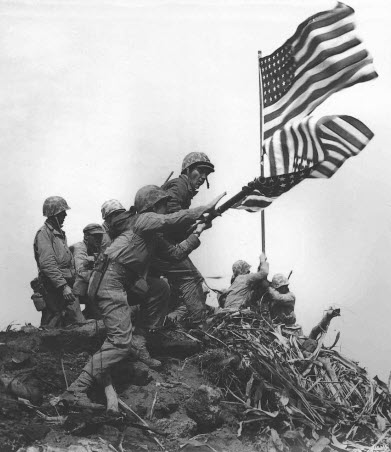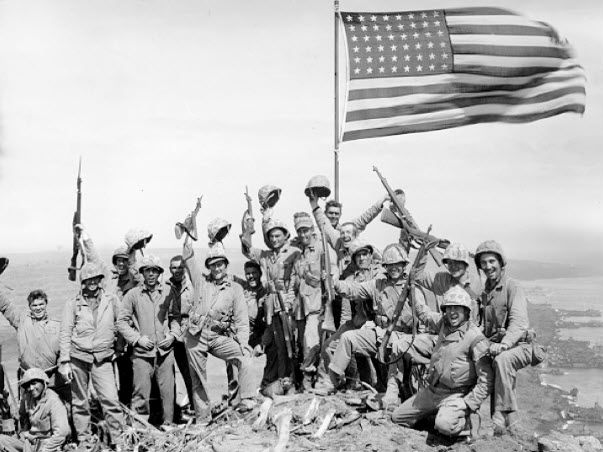 First flag raising photo
First flag raising photo
 Switching the two flags
Switching the two flags
 Second flag raising photo
Second flag raising photoimages from National Achieves, 15 February 2020.

Last modified: 2020-02-15 by rob raeside
Keywords: iwo jima | star-spangled banner | don't give up the ship | pearl harbor | us marine corps war memorial |
Links: FOTW homepage |
search |
disclaimer and copyright |
write us |
mirrors
On this page:
See also:
 First flag raising photo
First flag raising photo
 Switching the two flags
Switching the two flags
 Second flag raising photo
Second flag raising photo
images from National Achieves, 15 February 2020.
In high school a friend of mine told me that his father raised the flag on Iwo Jima. I thought he was pulling my leg but went along with the gag. Which guy in the statue is he? I asked. No, he replied the statue was the second raising. Dad put up the first. I continued to think he was just spinning a yarn until a few years later during the 25th anniversary of the raising the local TV stations interviewed a "local man who raised the flag on Iwo Jima" It was my friends father! OK, I thought, he wasn't pulling my leg after all.
Here's the scoop. The first flag raised was just a small flag one of the Marines was carrying (probably about 5 feet in length). This act was photographed (which is how Mr. Lindberg, my friend's father, is able to verify his claim). Later the Marines sent the famous group up to raise a larger flag. It was the second
raising, but not for the express purpose of taking the picture.
Nathan Bliss, 1 August 1996
Both the Iwo Jima flags are in the US Marine Corps museum at the U.S. Navy Yard in Washington, DC. The smaller one is the one first raised.
Nick Artimovich, 10 December 1997
The US Marine Corps War Memorial web page identifies the flag raisers as Corporal Harlon Block, Private First Class Rene Gagnon, Private First Class Ira Hayes, Private First Class Harold Schultz, Private First Class Franklin Sousley, and Sergeant Michael Strank. By-the-way, the tragic life of Ira Hayes, a Pima Indian who succumbed to alcoholism, is told in "The Ballad of Ira Hayes", recorded by both Bob Dylan and Johnny Cash, among others.
Ned Smith, 20 February 2000
Both of the Iwo Jima Flags raised in February of 1945 by the Easy Company of the 28th Marine Regiment are in the USMC Museum in the Washington Navy Yard. They were both recently conserved by the noted textile conservator Fonda Thompson. The story that only the 1st flag survived seems to stem form the recent book Flags of Our Fathers by James Bradley.
The first flag raised was an ensign from the USS Missoula measuring 28" x 54".
 First Iwo Jima flag
First Iwo Jima flag
image from the United States Marine Corps National Museum, 15 February 2020.
 Second Iwo Jima flag
Second Iwo Jima flag
image from the United States Marine Corps National Museum, 15 February 2020.
Charles Lindberg (not the aviator) lives in Minneapolis about 80 miles from here. He was at the raising of the US flag at Iwo Jima during the battle. Here is part of the story excerpted from a special education edition of the American Legion magazine Sept, 2002, made possible by American Legion Post 12 of Long Prairie, Minnesota, written by Rodger Johnston.
Lee Herold, 25 September 2006
Joe Rosenthal died on Sunday 20 August 2006 at the age of 94 in Novato, California.
Ivan Sache, 26 September 2006
The status of the island of Iwo Jima as part of the "Home islands" not withstanding; the first US flags raised or hoisted over pre-war Japanese territory occurred some months before at the Kwajalein Atoll.
At sea, it was when the USS Phelps dropped anchor; ashore it was a flag raised by the 4th Division, 25 Regiment, 2nd Battalion of the U.S. Marine Corps.
Jim Ferrigan, 26 September 2006
 Easy Company of the 28th Marine Regiment at the top of Mount Suribachi.
Easy Company of the 28th Marine Regiment at the top of Mount Suribachi.
image from National Achieves, 15 February 2020.
Since it was an active combat zone it is not surprising that confusion exists about exactly who physically raised the first and second flags - as some stood security, others helped gather materials, and some actually pushed the flags into place - but later the remaining soldiers of Easy Company posed for this less famous picture after the mountain was secured. It can be safely stated that Lieutenant Colonel Chandler Johnson, commander of the 2nd Battalion, 28th Marine Regiment, 5th Marine Division, ordered Marine Captain Dave Severance, 2nd Battalion, 28th Marines, to send a platoon to seize and occupy the crest of Mount Suribachi and place an American flag there. The company sent was Easy Company. First Lieutenant Harold Schrier lead a 40-man combat patrol up the mountain. Johnson had said to Schrier, "If you get to the top, put it up..." and they did.
Photographs of the first flag flown on Mount Suribachi were taken by Staff Sergeant Louis R. Lowery of Leatherneck magazine, who accompanied the patrol up the mountain. Those generally credited with getting the first flag raised were Lieutenant Harold Schrier, Platoon Sergeant Ernest Thomas, Sergeant "Hank" Hansen, Corporal Charles Lindberg, Private First Class James Michels, Private First Class James Robeson, and Navy Corpsman John Bradley.
A second flag was later carried up the mountain by Private Rene Gagnon with a message for Lieutenant Schrier to raise it and then send the other flag back down with Gagnon. Because of this Gagnon was later identified as one of the flag raisers. The actual second flag raisers in the photo are now identified as Sergeant Michael Strank, Corporal Harlon Block, Private First Class Franklin Sousley, Private First Class Ira Hayes, Private First Class Harold "Pie" Keller, and Private First Class Harold "Hank" Schultz. None of this could have happened without the assistance of all those who climbed and secured the mountain top.
Unfortunately Strank, Block and Sousley were all killed before the island was secured. Because of the "fog" of war, the War Department later ordered Ira Hayes, Rene Gagnon (who had bravely carried the flags up and down the mountain), and John Bradley (actually one of the first flag raisers) home as "flag raisers" depicted in the famous picture to help sell war bonds. Of the three sent home to sell bonds, only Hayes was actually in Joe Rosenthal's picture.
Pete Loeser, 15 February 2020.
 image from Pete Loeser, 15 February 2020
image from Pete Loeser, 15 February 2020
The Marine Corps War Memorial is a national memorial built in 1954 in Arlington Ridge Park, Arlington, Virginia, near one of the gates to Arlington National Cemetery. The war memorial honors all U.S. Marine Corps personnel who died in the defense of the United States since 1775. Its design is, of course, based on the 1945 photograph taken by Associated Press combat photographer Joe Rosenthal.
Pete Loeser, 15 February 2020
 image by Pete Loeser, 15 February 2020
image by Pete Loeser, 15 February 2020
This plain white fielded Iwo Jima flag is based on the Pulitzer Prize-winning photograph taken by news photographer Joe Rosenthal on February 23, 1945, and seems to be the only flag currently available to commemorate the 75th Anniversary of the historic battle to take the Japanese island of Iwo Jima.
Pete Loeser, 15 February 2020
 image by Joe McMillan, 16 January 2000
image by Joe McMillan, 16 January 2000
The "Don't Give Up The Ship" flag of Oliver Hazard Perry (War of 1812) and later Matthew
Perry's flag used to open Japan to the west (among lots of other flags) are at the U.S. Naval Academy in Annapolis, Maryland.
Nick Artimovich, 10 December 1997
 photo from U.S. Naval Academy, 15 February 2020
photo from U.S. Naval Academy, 15 February 2020
During the War of 1812, Captain James Lawrence, commanding the 49-gun frigate USS Chesapeake, was attacked off Boston Harbor by the British ship HMS Shannon. In less than 15 minutes, Lawrence's crew was overwhelmed. Mortally wounded, Lawrence shouted, "Tell the men to fire faster and not to give up the ship; fight her till she sinks!" True to his words, every officer in the Chesapeake's chain of command fought until they were either killed or wounded.
In honor of Captain Lawrence, a group of women stitched the words "DON'T GIVE UP THE SHIP" on a flag that was presented to Commodore Oliver Hazard Perry, who commanded a new ship named after Captain Lawrence in the summer of 1813. Perry and the USS Lawrence went on to capture an entire squadron of British ships in the Battle of Lake Erie, although not before every officer on the ship, except for Perry and his 13-year-old brother, was either killed or wounded.
Lawrence's words became the motto of the United States Navy, which has since named numerous ships in his honor, and Perry's flag now hangs in a place of honor at the United States Naval Academy.
Pete Loeser, 15 February 2020
 image from National Achieves, February 2020.
image from National Achieves, February 2020.
The U.S. flag that flew over the Capitol during attack on Pearl Harbor was taken down, then
flown in both Berlin and Tokyo at the end of the war. It is now in the H.S. Truman Library in Independence, Missouri.
Nick Artimovich, 10 December 1997
On April 6, 1948, the US flag which flew over the US national capitol at the time of the Pearl Harbor attack was returned to the capitol during the Army Day ceremonies. The flag had been raised over the three defeated Axis capital cities, Rome, Berlin and Tokyo after the World War II victory.
Pete Loeser, 15 February 2020